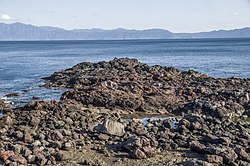| Cape Nagasakibana, Kagoshima 長崎鼻長崎鼻岬 | |
|---|---|
| Cape | |
 View from Cape Nagasakibana across Kagoshima Bay entrance to the end of the Ōsumi Peninsula View from Cape Nagasakibana across Kagoshima Bay entrance to the end of the Ōsumi Peninsula | |
 | |
| Coordinates: 31°09′19″N 130°35′12″E / 31.15528°N 130.58667°E / 31.15528; 130.58667 | |
| Location | Satsuma Peninsula |
| Offshore water bodies | Kagoshima Bay |
| Formed by | Volcanic action |
| Native name | 長崎鼻 |
Nagasakibana (長崎鼻, Nagasakibana), also known as Cape Nagasakibana (長崎鼻岬, Nagasakibana Misaki) or Cape Ryūgū, is the most southern headland on the Satsuma Peninsula at the entrance to Kagoshima Bay. The cape has a lighthouse, is the location of a statue of Urashima Tarō, the fisherman in a Japanese fairy tale, and the Ryūgū Shrine.
Geology
The cape is volcanic in origin and is at the southern border of the Ibusuki Volcanic Field.
Tourism
There are views from the cape, which is easy to access by car, or train, of both Mount Kaimon and the Satsuma Peninsula and nearby are local botanical and zoological gardens.
References
- ^ "Ryugu Shrine". Japan RAIL & TRAVEL. KOTSU SHIMBUNSHA. 24 September 2019. Archived from the original on 12 April 2020. Retrieved 12 April 2020.
- "Ryugu Shrine". KYUSHU x TOKYO. Archived from the original on 12 April 2020. Retrieved 12 April 2020.
- ^ "Cape Nagasakibana". Retrieved 2022-10-02.
- Nakamura, Masato (1980). "Possibility of New Volcanic Activity at Ibusuki Volcanic Field, Kyushu, Japan". Bulletin of the Volcanological Society of Japan. Second Series. 25 (3): 195–205. doi:10.18940/kazanc.25.3_195. ISSN 2433-0590.
This Kagoshima Prefecture location article is a stub. You can help Misplaced Pages by expanding it. |